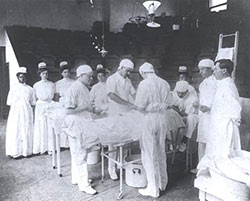The Flexner Report (1900-1926, Section 4)
Despite the passage of stricter licensing laws in many states, physicians continued to be concerned with the quality of health care in the United States and about the competition they received from individuals who lacked adequate training. They believed that an important way to enhance medical care was to improve and standardize medical education throughout the United States. Consequently, the AMA asked the Carnegie Foundation to investigate the nation’s medical schools.
1910
The Foundation hired Abraham Flexner, an educational reformer trained at Johns Hopkins and Harvard, to lead the study of American medical education, although he had never been inside a medical school. The Foundation published his report in 1910. The Flexner Report, as it was known, included his evaluations of more than 150 medical schools throughout the United States. Armed with the report, the AMA demanded higher standards in medical education. The AMA and its physician members also hoped to eliminate competition from other health care providers and to limit who could become a medical doctor.
Any school that failed to meet the new standards lost the AMA’s support. This support was vital because the Federation of State Medical Boards, established in 1912, accepted the AMA rankings of medical schools as authoritative. Nearly half of all medical schools that Abraham Flexner investigated failed to meet the new standards and closed within 20 years, including the majority of the medical schools educating women or African Americans. These schools had been regularly underfunded.
Of the six predominantly black medical schools still open in 1910 and inspected by Mr. Flexner, most closed within thirteen years of his report. Howard and Meharry were the only predominantly black medical schools that received passing grades and remained open.
Still denied admission to most predominantly white medical schools, African Americans now had fewer options for medical education. These circumstances, in turn, had profound impacts on the health of their communities.


